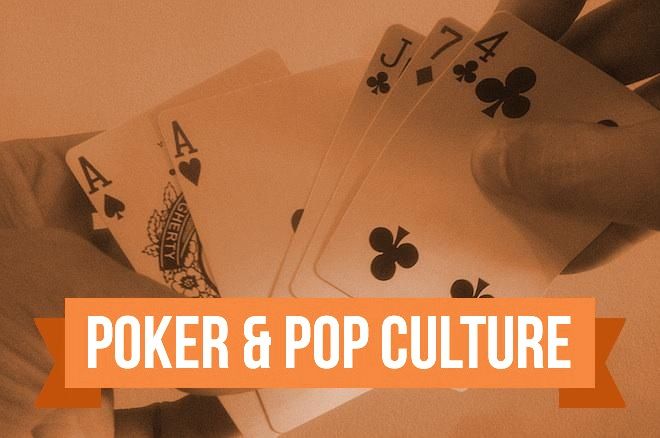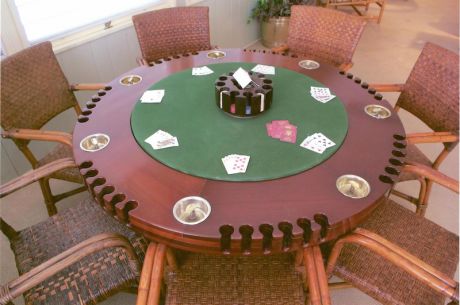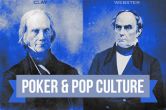Poker & Pop Culture: Life, Liberty, and the Pursuit of a Better Hand

Poker came to be during the first decades of the 1800s, not that long after the country in which the game originated first declared its independence. Both the game and the fledgling nation subsequently grew and developed together �� you could say both experienced significant territorial expansion throughout the 19th century.
Just as the ever-changing concept of what "America" was and stood for would swell to include a multitude of different ideals and values, so would poker evolve into a uniquely adaptable game allowing for a remarkable variety of rules, variants, and methods of play.
We've been discussing an initial poker variant called "Old Poker," a game that typically involved a smaller deck (i.e., 20 or 25 cards) and just one betting round following an initial deal. It goes without saying those who played the game didn't themselves call it "Old Poker" �� it only became "Old" after something new came along.
The first significant alteration to the game developed in part from the deck of cards expanding, too, growing to the standard 52-card deck used today.
More cards meant more players could be dealt into each hand. More cards also opened up another possibility, a rule change that some have likened to other "American" ideas of freedom, liberty, self-reliance, and the pursuit of happiness �� that idea that if you've been dealt a "bad hand" in life, well, you have the unalienable right to do something about it.
Okay, then... the action's on you. How many cards do you want?
Poker, According to Hoyle
Last week we were talking about a presidential candidate in 1844 being so well known for his poker playing some erroneously thought he'd invented the game, and how some who supported his opponent that year highlighted his penchant for poker as a reason not to vote for him.
It was the following year the first mention of poker appeared in an edition of Hoyle's Games, the popular series of books providing rules for various card games continued well after the death in 1769 of its namesake, Edmond Hoyle. Hoyle, you might recall, was included among the first round of Poker Hall of Fame inductees when that institution was created in 1979 �� despite the fact that he'd died decades before the game was invented.
The 1845 American edition of Hoyle compiled by Henry F. Anners added a few games described as "entirely new in this country," among them "Poker, or 'Bluff'" or the "full deck" version of the game.
The explanation covers how the dealer is chosen, procedures for handling exposed cards and misdeals, the employment of "counters" or "chips" to indicate stakes being wagered, and, significantly, the addition of flushes �� better than three of a kind, though not as high-ranking as a "full hand" or full house �� though not yet straights. Straight flushes and royal flushes are yet to register also, leaving four of kind atop the list of possible poker hands.
Also outlined are additional variations to game play, including the option to "double head" or "treble head," that is, to double or triple the stakes should all players decide not to "enter for the pool." Players can also agree to have the one sitting left of the dealer post a "blind" bet to induce action, with the minimum raise thereafter being twice the blind.
A short paragraph about "Twenty-Deck Poker" is included as well, showing that the 20-card variant was still sometimes played. But by then the smaller-deck version of the game was already on the way out, and by the 1850s references to it reduced considerably, fading entirely by the Civil War.
Much poker, then, still involved just the single deal of five cards, one round of betting, and a showdown. You had to play the hand you were dealt, good cards or bad. Stuck with ten-high and no pair? Bluff or get out.
Discard and Draw
In 1850 there appeared Bohn's New Hand-Book of Games, a book compiling contributions from "professors and amateurs" originally edited by Henry G. Bohn, then "enlarged and improved" by the addition of United States-specific games by Anners.
Here the poker discussion from the 1845 Hoyle is repeated verbatim, with the addition of a short addendum describing "Draw Poker" which tells of how "the player can draw from the pack as many cards as he may wish, �� not exceeding five, �� which must be given him by the dealer; but previous to drawing he must take from his original hand the same number as he may wish to draw."

This initial reference to draw poker describes a betting round occurring before the draw, though actually does not suggest a second round of betting after players have discarded and drawn in an effort to improve their hands.
Later, the 1864 American Hoyle compiled by William Brisbane Dick (working under the pseudonym "Trumps") would, however, establish the additional betting round as among the game's decided upon "laws." There one finds both a short description of "Straight Poker" (without a draw) and a longer one of "Draw Poker" with the latter resembling in most particulars the game with which most would be introduced to poker over the next century-plus.
Much later-used terminology was in place as well, with only a few now-obsolete terms still in play, such as "brag" still being used as a synonym for betting and "age" used to refer to the player with the "eldest hand" sitting to the left of the dealer and charged with acting first before the draw (something akin to today's "under the gun" player having to act first before the flop in hold'em).
A "straight sequence" or straight is also described as being sometimes included among the hand rankings, beating three of a kind with the ace capable of playing low or high to form one, though not yet uniformly accepted as part of five-card draw. "Straights are not considered in the game, although they are played in some localities," says "Trumps." Meanwhile flushes �� "five cards of all the same suit" �� are less equivocally included as part of the newly-accepted hand rankings, thereby nearly completing the modern-day chart of hands:
- high card
- one pair
- two pair
- three of a kind
- straight
- flush
- full house
- four of a kind
The straight flush �� that is, five cards of consecutive rank and the same suit �� is also brought up in the 1864 Hoyle as a current topic of debate among the game's new rule-makers.
"It is strongly urged by some experts that the strongest hand at Draw Poker should be a Straight Flush," a footnote explains, "for the reason that it is more difficult to get than four of a kind, and removes from the game the objectionable feature of a known invincible hand."
Math supports the argument of the "experts" regarding the relative rarity of straight flushes. With a 52-card deck producing 2,598,960 possible five-card combinations, only 40 result in straight flushes (1 in 64,974) compared to 624 ways to make four of a kind (1 in 4,165), making the latter greater than 15 times more likely.
There remains, of course, an "invincible" ace-high straight flush (A-K-Q-J-10 of one suit), soon to be dubbed a "Royal Flush" thanks to its employment of court cards, though with only four possible combinations (1 in 649,740) its rarity considerably reduces the likelihood of any player being dealt a "lock" hand.
Draw Poker, and the Frontier Spirit
Adding the draw surely added action with a second betting round, but it also added a strategy component lacking in "Straight Poker," a game which Dick describes much as the earlier Hoyles did as a game that "depends rather upon luck and energy than skill" and as "emphatically a game of chance."
The draw enables players with an understanding of odds and probabilities to outwit their opponents with their discards and bets. As we'll be discussing soon, once the first pamphlets and books discussing draw poker strategy begin to emerge and other cultural responses to the game appear, this obvious skill component made poker less easily to dismiss as just another gambling game. The "skill-versus-luck" debate was on!
For some, the addition of the draw additionally helped make poker a better match for the "American intellect" of the 19th century whose features were famously catalogued by Frederick Jackson Turner in his 1893 essay "The Significance of the Frontier in American History."
According to the historian, that constantly-present idea of the frontier and its suggestion of limitless opportunities fundamentally shaped the national character during the 1800s (and after, argue others). Among the most salient "traits of the frontier" exhibited by Americans, Turner lists "that coarseness and strength combined with acuteness and inquisitiveness; that practical, inventive turn of mind, quick to find expedients; that masterful grasp of material things, lacking in artistic but powerful to effect great ends; that restless, nervous energy; that dominant individualism, working for good and for evil, and withal that buoyancy and exuberance which comes with freedom."
Similarly would draw poker would prove attractive to the inventive, restless action-seeker who rather than accepting a poor hand as fate-determining would seek "expedients" by which to improve in the form of replacement cards.
Still More Expansion, Evolution
Two other variations added as postscripts to the discussion of poker in the 1864 Hoyle appear further designed to satisfy the desire for freedom to alter and change one's destiny.
One, "Whiskey Poker," despite being enthusiastically presented as "a neat variation of Draw Poker" and "a most amazing game," failed to catch on. That game involved an additionally-dealt five-card hand with which players could swap their original hands, then also allowed for the further exchange of cards with opponents' discards prior to the actual drawing round.
The other game "Trumps" brings up almost reluctantly. In fact, he sounds kind of embarrassed about its "not very euphonious name."
Stud.
From the forthcoming "Poker & Pop Culture: Telling the Story of America��s Favorite Card Game." Martin Harris teaches a course in "Poker in American Film and Culture" in the American Studies program at UNC-Charlotte.
Want to stay atop all the latest in the poker world? If so, make sure to get PokerNews updates on your social media outlets. Follow us on Twitter and find us on both Facebook and Google+!









